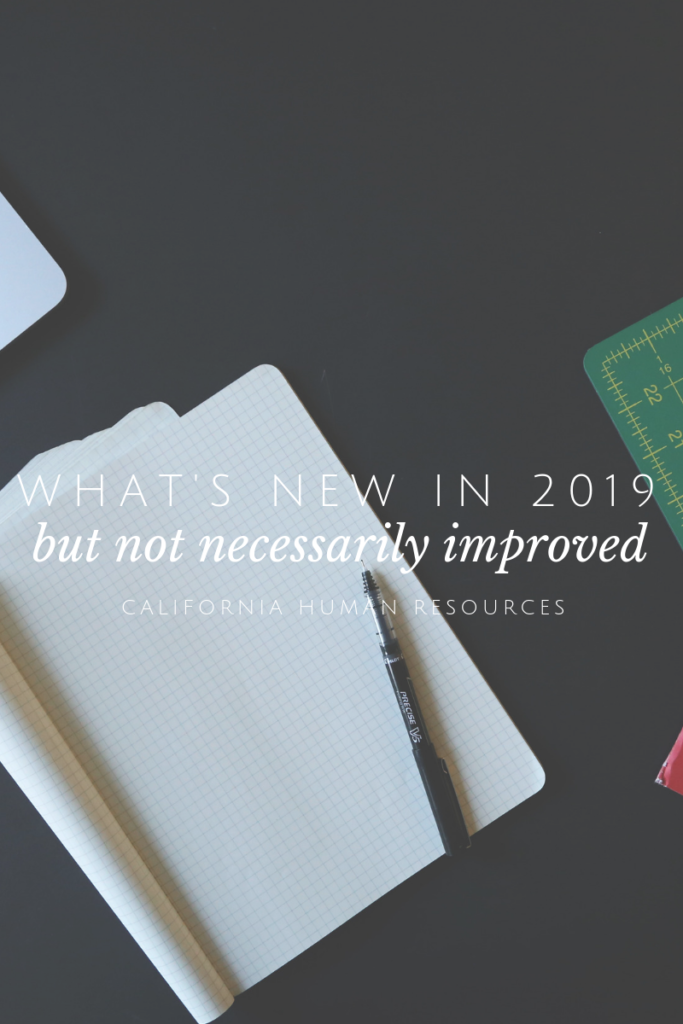
As we head to the end of the 2018, I’ve been thinking a lot about the world of Human Resources and what is going on in our industry. I’ve looked back at the questions our clients have asked this year and what the employment law attorneys, economic forecasters and HR professionals are anticipating for the new year and beyond. Here are the 3 critical areas of compliance which are also key areas of opportunity to create a great working environment:
Wage and Hour Compliance
Most California small businesses and organizations are still having challenges with Wage and Hour and other compliance issues.
MEAL AND REST BREAKS
Despite the Brinker court decision from 2015, it is still challenging to document meal and rest breaks. Every business needs to offer and encourage employees to take their mandatory meal and rest breaks (and take them at the right times!). Make sure supervisors understand this critical need and are communicating with their direct reports.
Businesses should add a certification/attestation to the time record where employees sign off that they received their breaks. If they didn’t for any reason, they need to identify why not and who (if anyone) was notified. Make sure you are paying the penalties if an employee has to skip a break or takes it late. Then discipline supervisors or employees when appropriate. Failure to be in compliance can cost your company thousands of dollars.
OVERTIME
Most businesses have a good grasp of the daily overtime requirement (you don’t get to choose whether to pay daily or weekly overtime). If you’ve implemented an Alternative Workweek Schedule (AWS) overtime may still be confusing. Review your Wage Order to see how specifically to pay overtime. The Industrial Wage Orders governs wage and hour for California entities and if you don’t know which one applies to you, click here: https://www.dir.ca.gov/dlse/WhichIWCOrderClassifications.PDF Post your Wage Order along with your giant All-In-One poster. Have questions about compliance? Let me know.

There’s been a wave of businesses and organizations that are offering training. Most popular topics include:
- Workplace Positivity,
- Team Building,
- Disability Awareness and the Reasonable Accommodation process,
- New Supervisor Training (ie., what tools do newly promoted or hired supervisors need in their tool box to be effective in their new role); and,
- Harassment Prevention for both supervisory and non-supervisory employees.
New Harassment Prevention Training Requirements
Governor Brown signed into law SB1343 which greatly expands the businesses required to provide the 2-hour supervisory harassment prevention training. Now small businesses with just 5 or more employees must comply. In addition, SB1343 also adds a one-hour training for all non-supervisory employees for businesses with 5 or more employees.
Businesses should start now because all the initial training needs to be completed by January 1, 2020 . The course certificates are good for 2 years. The Department of Fair Employment and Housing (DFEH) has been tasked with developing an online training program. No word yet on when that’ll be ready or if there will be a cost to use it or not. It is critical to be in compliance with this new regulation.
Discrimination – Focus on Disability & Age
There’s been an increased focus from both federal and state agencies investigating and enforcing policies and guidelines in their areas of authority. California’s DFEH released their 2017 Annual Report and age-related discrimination complaints have risen dramatically from 11% to almost 20%. It’s a good time to remind everyone that age protection covers employees age 40 and above. The DFEH is actively litigating claims and 74% of its 2017 claims that it filed were disability claims. It is crucial that businesses engage in the interactive process with employees and applicants who have a disability. And, of course, document, document, document.
The Interactive Process
The interactive process is also called the interactive dialogue. It essentially is a conversation between the employer and the employee about what limitations the employee has and what he/she thinks will be an effective accommodation in order to successfully perform the essential functions of the job. It is important that employers have at least one conversation with the employee but there isn’t an upper limit on those conversations. Have as many meetings as needed in order to get clarity about what accommodation will be best. You should take into consideration what an employee desires but the accommodation needs to meet both the employer’s and employee’s needs. In other words, an employee’s desire for an accommodation that is over-the-top doesn’t necessarily meet the employer’s needs.
Job Descriptions
Which brings us to the job description. If you haven’t updated your entire team’s job descriptions recently, it needs be one of your main “to do”items during the next 30 days. You need to make sure you clearly state the essential duties of the position and the physical requirements of the job. When engaging in the interactive dialogue, you need that data to understand what accommodations may be reasonable.
Make 2019 a spectacular year! To get help crafting your HR Action Plan, click here.
Note: I am not an attorney, I don’t play one on TV or on the Internet. This is not legal advice. These are HR Best Practices. If you need legal advice, contact your employment law attorney.
